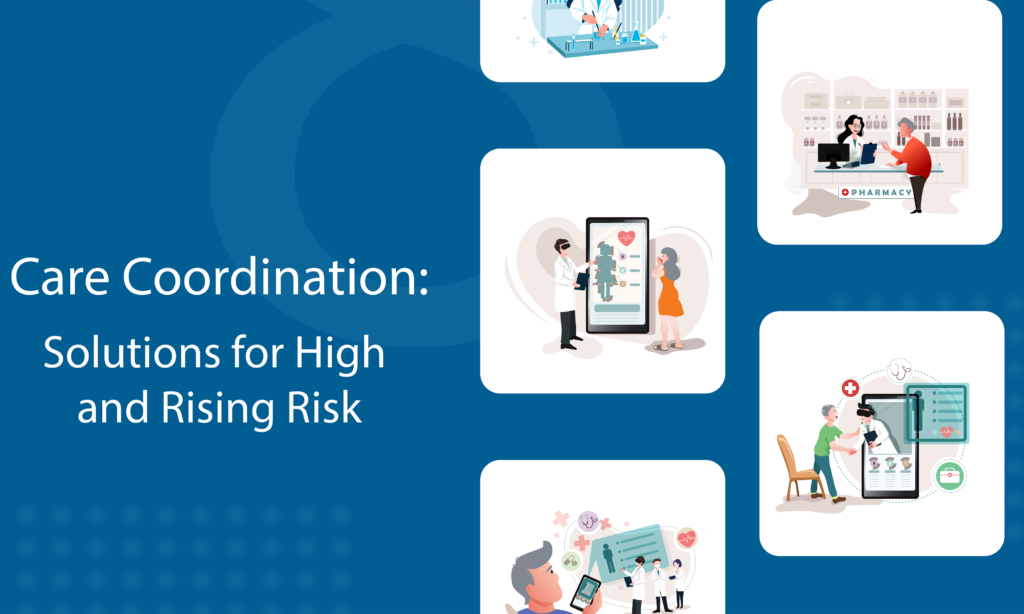When it comes to caring for rising-risk and high-risk patients, care coordination among various providers is critical. However, the pandemic has made care more complicated with its long-lasting effects brought by care disruptions, emotional toll, and financial burdens. In the same manner, coordinating care has also become increasingly complex involving providers from primary care and post-acute teams as well as home health agencies, health plans, and even patients themselves and their caregivers.
To ensure coordination is efficient, timely, and relevant, the solution starts with the ability to identify in near real-time the high-need patients to make appropriate interventions. This would entail active workflows to support care coordination and sophisticated models for advanced risk scoring.
So what makes for an effective care coordination solution?
Identifying who is at risk
High-risk patients are the high-cost and high-need ones with multiple chronic conditions and with functional limitations. Rising-risk patients are those who are not yet “high-need” or “high-cost,” but may be on the path to becoming one.
In this post-pandemic era, there is now a growing concern to define what “at risk” means. As part of ongoing efforts, the Center for Health Care Strategies with support from Kaiser Permanente Community Health and other complex care organizations took part in the Rising Risk Initiative in 2018. They looked for insights that contribute to the risk trajectory and identify the right interventions to stop it.
There were different ways that the concept of risk was approached in this initiative, namely, the effect of homelessness, the complexity of medication regimens, and the impact of fragmented care coordination. However, some common grounds were gained from all these efforts.
- Taking a population-wide approach – Using a cluster analysis model for the entire population is key in recognizing behavior patterns and previously unrecognized interactions with the healthcare system. This included patients with multiple chronic conditions who have lower engagement rates with primary care providers and also have no inpatient admissions.
- Factoring in social risk – This entails collaboration with community partners and using publicly available data sources. This included looking into signals of rising social risk like a change in marital status or multiple changes of addresses within a short period. However, for robust risk stratification models, social data may not improve predictive capabilities but can give insights into the kinds of interventions that will be most effective.
- Validating with frontline staff – To best confirm the data analytics model, the insights of the frontline staff will be valuable in identifying patients who will most likely be less stable or costly over time. This will also educate the staff on the concept of rising risk.
Pressing issues in caring for patients at risk
To better understand what urgent solutions are needed, there is a need to first recognize the pressing issues in caring for high and rising-risk patients. These concerns include delays in care transition, emerging social issues that affect access to care, and the shortage of medical resources and staff.
Delays significantly impact patient outcomes and often occur when providers do not have a complete picture or data to ascertain high-priority patients. Risk-stratification algorithms are still based on old claims data. This is further aggravated when care coordinators do not have clarity in follow-up workflows once they obtain information on patients at risk.
In an ideal setup, the primary care physician needs to identify care goals for high and rising-risk patients instead of patients already in crisis. This does not always happen because of certain challenges, particularly for short-staffed practices that do not have the right resources and data to identify priority patients.
Clearly, there is a need for creative approaches to address these concerns and ensure that patients obtain high-quality, cost-effective care, and timely care. This will streamline and expedite the management of multiple providers and reduce avoidable delays.
Care coordination solutions
Providers can utilize the following technology solutions and innovative programs to facilitate better coordination:
1. Advanced analytics
Providers can leverage advanced analytics to identify high-risk and rising-risk patients. There are now various technology solutions using different indicators to identify and categorize patients such as a readmission risk assessment that looks into psychosocial factors as well as medications. It can identify patients in need of palliative care who have physical limitations.
Providers can score their patients to serve as a basis to monitor them. Another approach is to incorporate a readmission alert into their EHR to determine if a patient has been readmitted within 30 days from initial admission. Practices can also benefit from a daily risk stratification report that tells the number of patients at risk. These same indicators can be used to help providers determine rising-risk patients who have multiple chronic conditions, are overutilizing or underutilizing Medicare or are uninsured or underinsured.
2. New and innovative programs
It is critical to reach every patient who needs complex care. New and innovative programs are currently in the works such as the FDA’s pre-certification program or pre-cert, ongoing partnerships to address social determinants of health (SDoH), real-time information with efficient follow-up workflows, and engaging pharmacists in medication management.
The newly introduced pre-certification program will help facilitate the transition from the hospital to post-acute care with better health outcomes. This new program will reduce turnaround times to eight hours from 72 hours and save 4,000 days in under a year. It will also benefit providers by reducing claims denials by meeting the utilization management criteria.
To address growing social issues, partnerships with community and church organizations will resolve SDoH and psychosocial issues as well as isolation and loneliness that were further aggravated by the pandemic. Leading healthcare systems like IU Health in Indianapolis have created a congregational care network by partnering with congregations across Indiana. Meanwhile, technology leaders in healthcare have developed solutions to help providers identify high-risk and multi-visits patients in near real-time and better workflows to streamline processes in delivering care and managing costs.
New pharmacy models will engage pharmacists in medication management for high and rising-risk patients. This will enable timely support during the medication reconciliation with access to relevant data at the site of care.
3. Risk identification models
Critical to proactively determining high-priority patients is to have patient data that is supported by artificial intelligence (AI) and machine learning (ML). Software companies will play an important role in further advancing AI and ML to ensure patient data is accurate, on time, and helpful in aiding sound clinical decision-making.
To illustrate, some models can sort patients by their zip codes to identify those who are affected by food insecurity, transportation problems, and other concerns that may hinder access to care. Meanwhile, an EMR algorithm can identify patients into categories, namely, low, moderate, or high risk.
4. Staff augmentation
The healthcare industry needs to maximize different skill sets in managing high-priority patients. Social workers are positioned uniquely to find the root causes of why patients are at high risk. They can contribute to caring for complex care patients by focusing on financial considerations, which is valuable in care coordination. Practices should invest more in staff augmentation like utilizing the help of community health workers.
A partnership that works
Ascent Care Partners provides virtual healthcare services on your behalf. We work with primary care physicians and other providers in optimizing their patient care and capitalizing on Medicare’s remote monitoring and care coordination codes. Through our turnkey programs like Remote Patient Monitoring (RPM) and Chronic Care Management (CCM), ACP has helped practices grow clinically and financially.
We work with the following providers:
- Primary Care Physicians
- Family Practice Physicians
- Internists
- Physician Assistants
- Nurse Practitioners
- Gerontologists
- Non-Interventional Cardiologists
- Endocrinologists
- Wound Care Doctors
- and other providers



